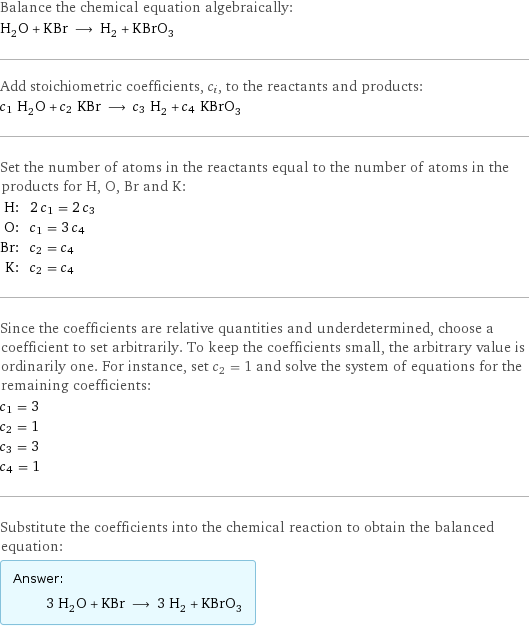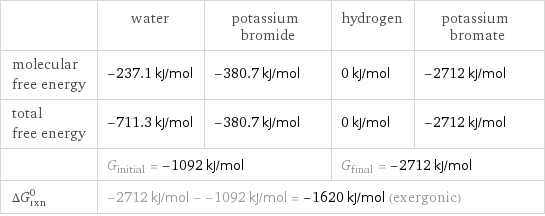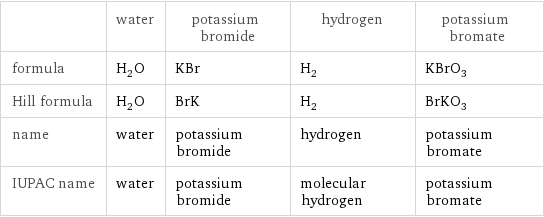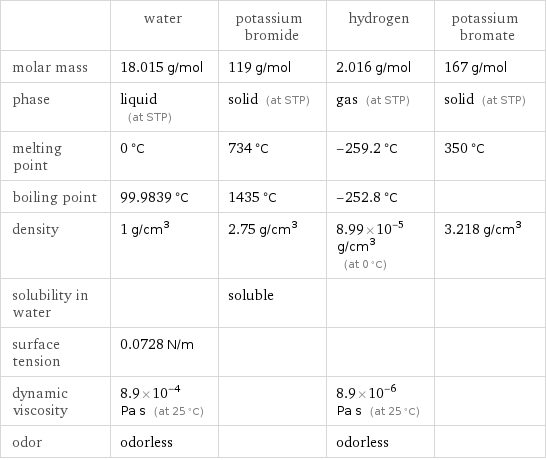Input interpretation

H_2O water + KBr potassium bromide ⟶ H_2 hydrogen + KBrO_3 potassium bromate
Balanced equation

Balance the chemical equation algebraically: H_2O + KBr ⟶ H_2 + KBrO_3 Add stoichiometric coefficients, c_i, to the reactants and products: c_1 H_2O + c_2 KBr ⟶ c_3 H_2 + c_4 KBrO_3 Set the number of atoms in the reactants equal to the number of atoms in the products for H, O, Br and K: H: | 2 c_1 = 2 c_3 O: | c_1 = 3 c_4 Br: | c_2 = c_4 K: | c_2 = c_4 Since the coefficients are relative quantities and underdetermined, choose a coefficient to set arbitrarily. To keep the coefficients small, the arbitrary value is ordinarily one. For instance, set c_2 = 1 and solve the system of equations for the remaining coefficients: c_1 = 3 c_2 = 1 c_3 = 3 c_4 = 1 Substitute the coefficients into the chemical reaction to obtain the balanced equation: Answer: | | 3 H_2O + KBr ⟶ 3 H_2 + KBrO_3
Structures

+ ⟶ +
Names

water + potassium bromide ⟶ hydrogen + potassium bromate
Reaction thermodynamics
Enthalpy

| water | potassium bromide | hydrogen | potassium bromate molecular enthalpy | -285.8 kJ/mol | -393.8 kJ/mol | 0 kJ/mol | -360.2 kJ/mol total enthalpy | -857.5 kJ/mol | -393.8 kJ/mol | 0 kJ/mol | -360.2 kJ/mol | H_initial = -1251 kJ/mol | | H_final = -360.2 kJ/mol | ΔH_rxn^0 | -360.2 kJ/mol - -1251 kJ/mol = 891.1 kJ/mol (endothermic) | | |
Gibbs free energy

| water | potassium bromide | hydrogen | potassium bromate molecular free energy | -237.1 kJ/mol | -380.7 kJ/mol | 0 kJ/mol | -2712 kJ/mol total free energy | -711.3 kJ/mol | -380.7 kJ/mol | 0 kJ/mol | -2712 kJ/mol | G_initial = -1092 kJ/mol | | G_final = -2712 kJ/mol | ΔG_rxn^0 | -2712 kJ/mol - -1092 kJ/mol = -1620 kJ/mol (exergonic) | | |
Equilibrium constant
![Construct the equilibrium constant, K, expression for: H_2O + KBr ⟶ H_2 + KBrO_3 Plan: • Balance the chemical equation. • Determine the stoichiometric numbers. • Assemble the activity expression for each chemical species. • Use the activity expressions to build the equilibrium constant expression. Write the balanced chemical equation: 3 H_2O + KBr ⟶ 3 H_2 + KBrO_3 Assign stoichiometric numbers, ν_i, using the stoichiometric coefficients, c_i, from the balanced chemical equation in the following manner: ν_i = -c_i for reactants and ν_i = c_i for products: chemical species | c_i | ν_i H_2O | 3 | -3 KBr | 1 | -1 H_2 | 3 | 3 KBrO_3 | 1 | 1 Assemble the activity expressions accounting for the state of matter and ν_i: chemical species | c_i | ν_i | activity expression H_2O | 3 | -3 | ([H2O])^(-3) KBr | 1 | -1 | ([KBr])^(-1) H_2 | 3 | 3 | ([H2])^3 KBrO_3 | 1 | 1 | [KBrO3] The equilibrium constant symbol in the concentration basis is: K_c Mulitply the activity expressions to arrive at the K_c expression: Answer: | | K_c = ([H2O])^(-3) ([KBr])^(-1) ([H2])^3 [KBrO3] = (([H2])^3 [KBrO3])/(([H2O])^3 [KBr])](../image_source/da92bbfd147213d8680b0299232ec709.png)
Construct the equilibrium constant, K, expression for: H_2O + KBr ⟶ H_2 + KBrO_3 Plan: • Balance the chemical equation. • Determine the stoichiometric numbers. • Assemble the activity expression for each chemical species. • Use the activity expressions to build the equilibrium constant expression. Write the balanced chemical equation: 3 H_2O + KBr ⟶ 3 H_2 + KBrO_3 Assign stoichiometric numbers, ν_i, using the stoichiometric coefficients, c_i, from the balanced chemical equation in the following manner: ν_i = -c_i for reactants and ν_i = c_i for products: chemical species | c_i | ν_i H_2O | 3 | -3 KBr | 1 | -1 H_2 | 3 | 3 KBrO_3 | 1 | 1 Assemble the activity expressions accounting for the state of matter and ν_i: chemical species | c_i | ν_i | activity expression H_2O | 3 | -3 | ([H2O])^(-3) KBr | 1 | -1 | ([KBr])^(-1) H_2 | 3 | 3 | ([H2])^3 KBrO_3 | 1 | 1 | [KBrO3] The equilibrium constant symbol in the concentration basis is: K_c Mulitply the activity expressions to arrive at the K_c expression: Answer: | | K_c = ([H2O])^(-3) ([KBr])^(-1) ([H2])^3 [KBrO3] = (([H2])^3 [KBrO3])/(([H2O])^3 [KBr])
Rate of reaction
![Construct the rate of reaction expression for: H_2O + KBr ⟶ H_2 + KBrO_3 Plan: • Balance the chemical equation. • Determine the stoichiometric numbers. • Assemble the rate term for each chemical species. • Write the rate of reaction expression. Write the balanced chemical equation: 3 H_2O + KBr ⟶ 3 H_2 + KBrO_3 Assign stoichiometric numbers, ν_i, using the stoichiometric coefficients, c_i, from the balanced chemical equation in the following manner: ν_i = -c_i for reactants and ν_i = c_i for products: chemical species | c_i | ν_i H_2O | 3 | -3 KBr | 1 | -1 H_2 | 3 | 3 KBrO_3 | 1 | 1 The rate term for each chemical species, B_i, is 1/ν_i(Δ[B_i])/(Δt) where [B_i] is the amount concentration and t is time: chemical species | c_i | ν_i | rate term H_2O | 3 | -3 | -1/3 (Δ[H2O])/(Δt) KBr | 1 | -1 | -(Δ[KBr])/(Δt) H_2 | 3 | 3 | 1/3 (Δ[H2])/(Δt) KBrO_3 | 1 | 1 | (Δ[KBrO3])/(Δt) (for infinitesimal rate of change, replace Δ with d) Set the rate terms equal to each other to arrive at the rate expression: Answer: | | rate = -1/3 (Δ[H2O])/(Δt) = -(Δ[KBr])/(Δt) = 1/3 (Δ[H2])/(Δt) = (Δ[KBrO3])/(Δt) (assuming constant volume and no accumulation of intermediates or side products)](../image_source/fa953ae8fc9e937f48e081f6b2657d1b.png)
Construct the rate of reaction expression for: H_2O + KBr ⟶ H_2 + KBrO_3 Plan: • Balance the chemical equation. • Determine the stoichiometric numbers. • Assemble the rate term for each chemical species. • Write the rate of reaction expression. Write the balanced chemical equation: 3 H_2O + KBr ⟶ 3 H_2 + KBrO_3 Assign stoichiometric numbers, ν_i, using the stoichiometric coefficients, c_i, from the balanced chemical equation in the following manner: ν_i = -c_i for reactants and ν_i = c_i for products: chemical species | c_i | ν_i H_2O | 3 | -3 KBr | 1 | -1 H_2 | 3 | 3 KBrO_3 | 1 | 1 The rate term for each chemical species, B_i, is 1/ν_i(Δ[B_i])/(Δt) where [B_i] is the amount concentration and t is time: chemical species | c_i | ν_i | rate term H_2O | 3 | -3 | -1/3 (Δ[H2O])/(Δt) KBr | 1 | -1 | -(Δ[KBr])/(Δt) H_2 | 3 | 3 | 1/3 (Δ[H2])/(Δt) KBrO_3 | 1 | 1 | (Δ[KBrO3])/(Δt) (for infinitesimal rate of change, replace Δ with d) Set the rate terms equal to each other to arrive at the rate expression: Answer: | | rate = -1/3 (Δ[H2O])/(Δt) = -(Δ[KBr])/(Δt) = 1/3 (Δ[H2])/(Δt) = (Δ[KBrO3])/(Δt) (assuming constant volume and no accumulation of intermediates or side products)
Chemical names and formulas

| water | potassium bromide | hydrogen | potassium bromate formula | H_2O | KBr | H_2 | KBrO_3 Hill formula | H_2O | BrK | H_2 | BrKO_3 name | water | potassium bromide | hydrogen | potassium bromate IUPAC name | water | potassium bromide | molecular hydrogen | potassium bromate
Substance properties

| water | potassium bromide | hydrogen | potassium bromate molar mass | 18.015 g/mol | 119 g/mol | 2.016 g/mol | 167 g/mol phase | liquid (at STP) | solid (at STP) | gas (at STP) | solid (at STP) melting point | 0 °C | 734 °C | -259.2 °C | 350 °C boiling point | 99.9839 °C | 1435 °C | -252.8 °C | density | 1 g/cm^3 | 2.75 g/cm^3 | 8.99×10^-5 g/cm^3 (at 0 °C) | 3.218 g/cm^3 solubility in water | | soluble | | surface tension | 0.0728 N/m | | | dynamic viscosity | 8.9×10^-4 Pa s (at 25 °C) | | 8.9×10^-6 Pa s (at 25 °C) | odor | odorless | | odorless |
Units
